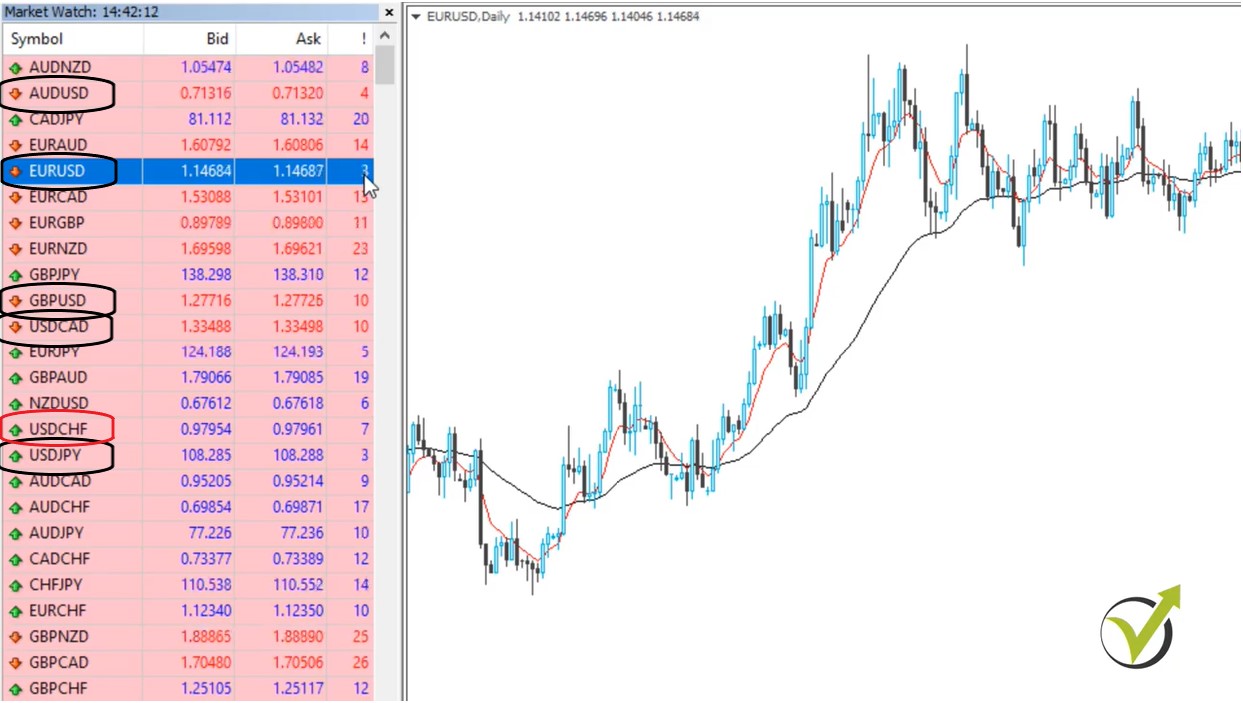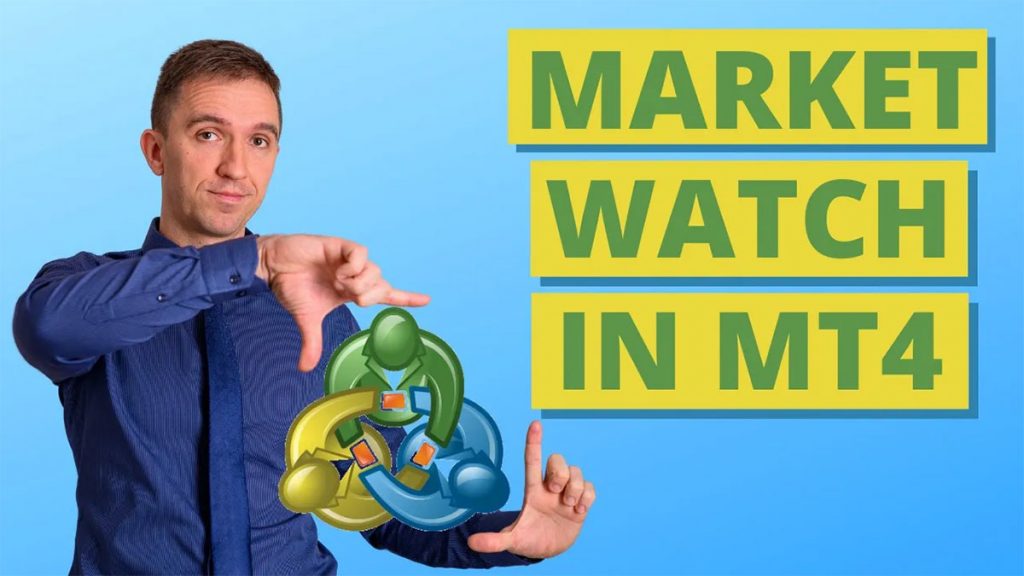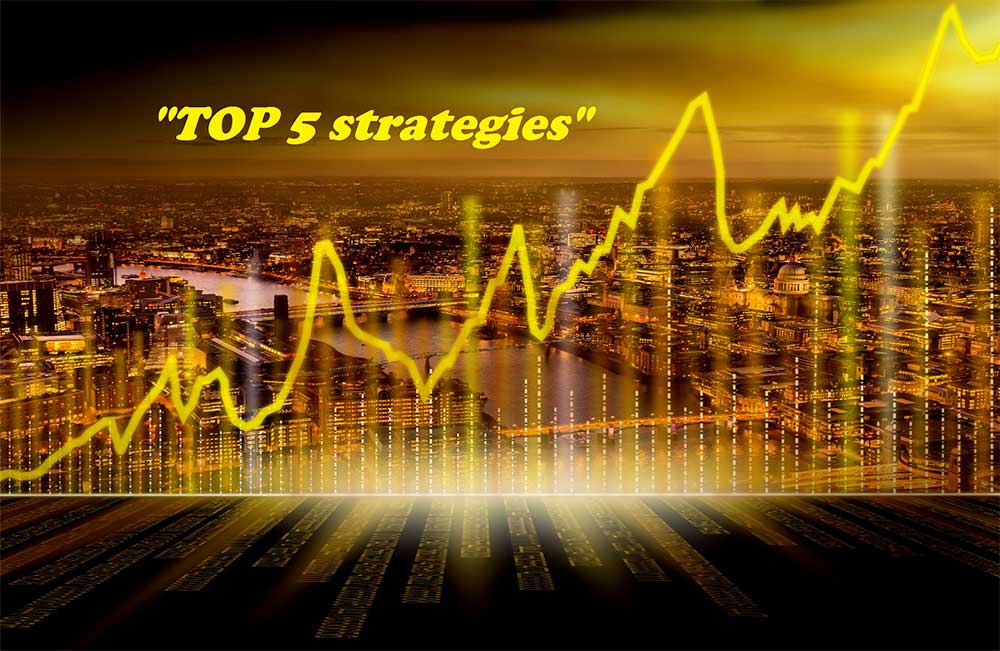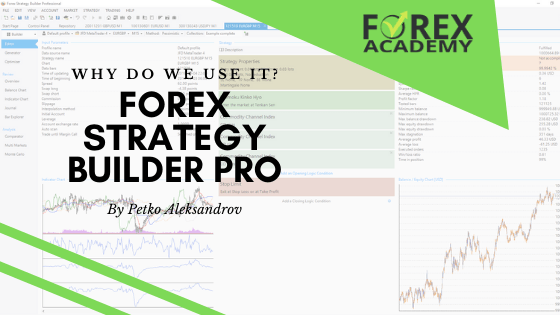Marketwatch in MetaTrader 4 is where we see the currencies on the left side of MetaTrader.
Marketwatch is what I am going to talk about. My name is Petko Aleksandrov, Head Mentor at Forex Academy, and in this article, I will introduce you to the Marketwatch in MetaTrader. This is the place where we have all the assets provided by the broker. From there we can choose which asset to trade, and at the same time, we have an overview of all prices at the moment. MetaTrader is the most common platform for Forex trading, and most of the broker provide it for free. Also, it is suitable for algorithmic trading which makes it the most wanted trading platform.
The article is free lecture from the course MetaTrader 4 Forex platform: Start trading with a pro trader.
Now, normally when you install the MetaTrader you will not see all of the assets provided by the broker. So what you need to do is you need to right-click on any of the assets and go to “show all” and you can see how many more assets were added to the Marketwatch:

We have the currencies on the top. Then below we have some indexes and then we have some stocks or commodities. And with some of the brokers, we have the cryptocurrencies. And it really depends what broker you have selected.
Also, in the MarketWatch, we have the oil, the brand crude oil and we have the Bitcoin on the bottom. And as you see the different categories of assets are with different colors. This way it is easier for the trader to look for any of the assets. And if you’re looking for any asset what you can do is you can use your keyboard. For example, if I am looking for the GBPNZD let’s say I will click on G and I will go to GBPJPY, GBPUSD if I click one more time GBPAUD and then it goes to GBPNZD. So it will start showing all the currencies starting with the pound. Starting with the G.
Now let’s say I am looking for the gold and I will press the X and it goes to the silver first and then you can see the next one is the gold. So you can use your keyboard just press the first letter of the asset you were looking for and you will start jumping to all assets starting with this letter so it will be easier for you to find it.
Now here normally we have 3 columns:
How to view the spread in the Marketwatch of MetaTrader 4?
- on the left is the symbol
- in the middle is the bid price
- then we have the asking price
- spread is the fourth column which is hidden
Now for the very very newbie traders here, I will mention that we have two prices because we buy on the Ask price and we sell on the Bid price. So for example, if I take EURUSD, the one I have over the chart. You can see I have 1.14628 and then I have 1.146345 it’s changing, right. So the Ask price, if you look carefully, it is bigger than the Bid price all the time.
Which means that I’m having the difference here between these two and this difference is called spread. So basically this is what our broker benefits.
The broker always benefits the spread.
Meaning that we will buy on the more expensive price, on the Ask price, and we will close the position or we will sell it back on the Bid price ( In the Market watch they are written as Bid and Ask).
So it’s not like I am paying the spread to the broker. Normally every trader says “I pay the spread”, “we paid the spread”, ” how much spread we pay”. And we can take it as a true because we buy on the more expensive price and we sell on the cheaper price, but it’s not an actual payment that we do for the transaction okay it’s not a fee that we pay.
It is just we buy on the more expensive price and we sell on the cheaper price and this is actually the best way that you can remember it. And you can see the spread by right click one more time and I will go to “spread”. So it will appear as a fourth column right here. And normally with the EURUSD, we have one of the cheapest spreads. And as you can see for the others it is a bit more it’s changing.
Actually, we have a small spread for the major currencies.
These are the EURUSD, the AUDUSD (all these stands for Australian dollar versus the American dollar which is kind
of slang the AUDUSD). And then we have GBPUSD, the slang here is “Cable” by the way, and then we have what we have below is USDCHF:

Well USDCHF it’s a kind of doubt nowadays it is a major currency after it was released from the euro. Anyway, it was considered before that to be a major currency and the USDJPY as well is a major currency. And with these currencies, we have a smaller spread. With some of the cross pairs, we call them cross pairs. The ones that are not with the American dollar such as GBPAUD or EURNZD.
We call them cross pairs and there the spread is just a little bit higher. Now it is up to you if you want to keep the spread column, but personally, I prefer to keep it. It is good to monitor all the time how much is the
spread with the broker because what happens normally is people open an account with a broker, they choose a broker with a small spread and they take it that the spread will be small all the time.
But of course the brokers change that and they can change it at any time.
Especially, what happened with Bitcoin during this time last year. It was a really crazy market with Bitcoin. So the spreads were floating from ten dollars up to two hundred dollars and with some of the brokers the spreads were really really high and many people were losing just because they didn’t notice what a spread the broker has selected to place. And it was really really hard to trade on such a high spread. But this was an exceptional case.
Normally, with the currency pairs, the spread is in a small range. For example, for the major pairs is somewhere between two-three points up to ten points or one pip. And with the cross pairs is between ten to twenty and of course with some is above twenty points or two pips.
Now to make it clear as well for the very newbie traders here.
What are the pip and the point in the MarketWatch?
The pip this is the fourth digit that we have with the five digits broker. So this is a five-digit broker as you see after the decimal comma where is the EURUSD, right? Аfter the decimal comma, we have one, two, three, four, five and with very simple words the fourth one is the pip and the last one is the point. And obviously, ten points equal to one pip.
So here we can say that the price is 1.1468 pips. It’s 68 pips the third and the fourth one and the last one is the point. So it’s 68 pips and 9 points or 8 points because it’s changing. And with the regulated brokers, we need to have in mind that with the major currencies we definitely need to have spread below one pip. So it should be in points.
For me having a broker with spreads of points and not in pips is good enough. It means the broker has a low spread and of course, it’s very important to have a lot of spread. I hope I made it very clear here with these simple explanations. I really don’t like query and you will not see slides in my courses where I will explain a long theory, I prefer to explain it very practically showing it over the chart.
And one last thing here about the MarketWatch.
If I right-click on it I will go to “specification”. This is where I see the specification of the asset:

So for this broker for the EURUSD what we have we have floating spread. As you see the spread is not fixed but it’s changing all the time.
Normally, it depends on the volatility of the market. When there is some volatility, some important news on the market you will see the spread a little bit higher and then when the market is calm you will see it on the regular levels. And this is what we call floating spread.
We have five because this is a five digit broker. And nowadays actually is very hard to find four digit broker anymore most of them are with five digits. And then we have contract size 100,000. This means that one lot equals to 100,000. If I buy one lot of EURUSD this is the quantity that we can buy. We are buying actually one hundred thousand Euro versus the American dollar. The margin currency here as in Euro.
The first one that we have and the pair and below we have what is the margin percentage. And I will explain about the margin later on and where you see it on the Metatrader. And what we have below is the minimal volume of 0.01. Which will actually equal to one thousand contract size. 0.01 is like we buy one thousand Euro versus the Dollar. The maximal volume here is one thousand and a volume step is 0.1. Here we have swap long and swap short.
Now keep in mind that here as well the brokers change the swap with the time. And for the moment we have -13.1/ 1.25 and then we have swap short of positive 6.075. Which means that if I am having a long position if I buy the EURUSD and I keep this position overnight it will charge me with a swap.
What is the negative swap?
The swap is the cost that we pay to the broker to hold our position overnight. And swap short is if we have a sell position, a short position. So when we buy we say it’s a long position when we sell we say it’s a short position.
Now having a short position, in this case, will bring us some benefit of having a positive swap. If I keep the trade overnight it will bring me this positive swap. Some of the brokers calculated as a percentage. You can see this is in points. And we have below the session hours when the market is opened for this broker.
All right, guys? Now very important here is to monitor what is the time on your broker. Now with me personally being in Bulgaria I am having two hours difference for this broker as this broker is so having the UK time or the GMT time. And it shows 2 p.m. and 47 minutes my local time now is 4 p.m. and 47 minutes. So when you install Metatrader have a look at the hour just in front of the MarketWatch. And it is very important because the hour sometimes is very very important for some strategies that you might have.
OK, guys? This is about Marketwatch.
What we have in the Marketwatch in Meta Trader?
- assets
- Bid price
- Ask price
- spread
These are the most important things that you need to know about the Marketwatch in Metatrader.
This is a free lecture from the MetaTrader 4 Forex platform: Start trading with a pro trader course. This is a complete guide to the MetaTrader platform, and every beginner who wishes to use the platform for trading will gain stable knowledge and confidence after watching the course.
In this course, I have covered all features available in MetaTrader, such as the Marketwatch, Navigator, Terminal, etc, and you will learn how to use the platform with its full capacity.
Thank you for reading. If you have any questions or interesting topics you can always write in the Forum, which you can find on our website.
Cheers!



